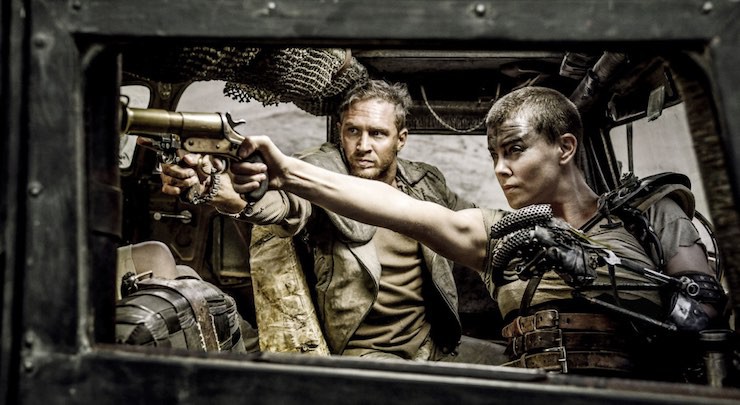Walking out of the theater after seeing Mad Max: Fury Road for the first time felt like nothing so much as a conversion experience. I knew that what I’d seen had changed how I would view all action movies from that point forward, and had both challenged me to do more with my own storytelling and provided a glimpse at a roadmap of how to do better.
I’ve loved action movies, comics, and stories for nearly my whole life. I’ve watched and read a lot of them. With that in mind, I want you to know that I watched the first thirty-something minutes of Mad Max: Fury Road with my jaw on the floor. I caught my breath when the flare went out, then maybe twice more during the film. I was completely transported to a world of visual action perfection, where movement and combat was crisp and clear, where character was communicated in every little movement, and where a two-hour chase sequence was also a Guide to Dismantling the Patriarchy.
The way that the film uses action, and specifically uses action to reveal and develop character, is a master class that I hope to keep learning from for the rest of my life.
There are a number of factors that I think go into Fury Road’s excellence in using action to reveal and develop character.
Conflicting Priorities
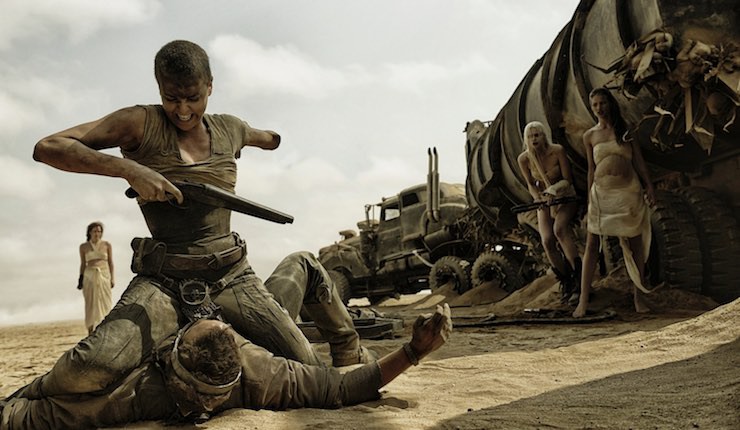
The fight at the War Rig is one of the most narratively impressive fight scene in film in years. (This is the fight when Max, Nux, Furiosa, and the Wives all come into conflict over control of the rig and the situation). The fight is not big on spectacle—it’s far more restrained, in part by being not on/in vehicles, but also due to the fact that the lethal weapons involved are very limited.
But despite, or really because of that, there are so many dramatic questions and conflicted/overlapping priorities going on. Max, Furiosa, Nux, and the Wives all want slightly different things in the fight, and work with and against other characters in pursuit of their own agendas.
The chain binding Max to Nux is a great prop in the fight, used by all sides in different ways at different times. In creating a continuous physical connection between two of the combatants, it gives the combatants and therefore the choreographer something interesting to work with.
Though in this scene, the four parties’ agendas differ in small and large degrees:
- Max wants to get un-chained/un-muzzled and to escape Immortan Joe’s Posse.
- Nux wants to reclaim the Wives (probably by killing Furiosa).
- Furiosa wants to get rid of the threats to her mission to escape with the Wives.
- The Wives want to escape without any unnecessary killing.
Throughout the scene, these agendas line up and conflict in interesting ways that give the fight a lot of nuance. Three of the four parties want to escape, but Max doesn’t want to share with anyone. Max and Nux both want to control the War Rig, but for different ultimate purposes. Furiosa and the Wives want to escape Max and Nux, but the Wives want to do so without killing if they can avoid it (largely due to Angharad’s influence).
Because the Wives are largely non-combatants, their relationship to the struggle is different than the others. Nux is unconscious for part of the fight, subdued for others. This means that there are four parties overall in the fight, but their level of involvement rises and falls over the course of the fight, adding variations along another dramatic axis.
But the real star in the fight is Furiosa. She fights with every single ounce of her being, making it very clear that her name is well-earned. She displays her knowledge of the rig, going for the hold-out pistol that no one else knows about, and even without it, she is Max’s equal in a straight-up brawl. She displays an acute awareness of timing and social savvy in opening the fight, seeing exactly when Max’s attention is split so she can charge him. In this fight, we learn more about just how far Furiosa is willing to go to achieve her goal, as well as seeing the motivations and morals of the other characters tested in practice.
What will and won’t Max do to escape? What does Nux do when given the chance for direct action again? Will he attack Max or focus on the Wives and Furiosa? All of this is character revealed and developed through action.
Blood Bag to Road Warrior
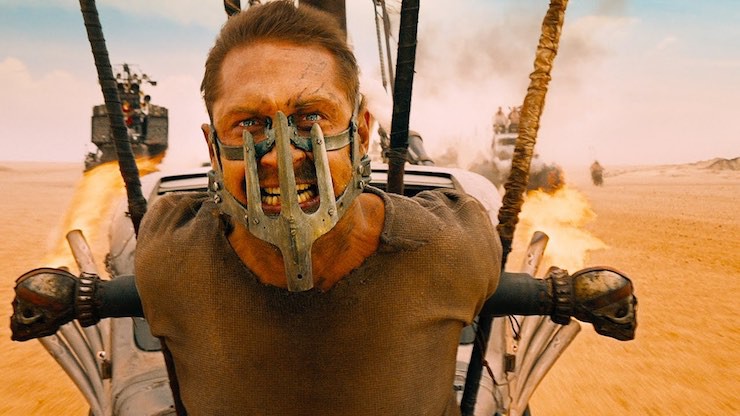
Despite being the title character, Max has relatively little dialogue. But Max is definitely the protagonist in a classic sense, as has the most substantial character arc in the film.
Max starts as a wild wanderer without purpose, has his whole world (his car) taken from him and is made into a blood bag, reduced to a living battery. Escaping, he becomes a caged animal (literally muzzled) threatening Furiosa and the Wives. He becomes an ally of convenience, and in interacting with Furiosa and the Wives, he starts to shake off the toxic masculinity of a world defined by Immortan Joe. Fighting alongside them, he remembers himself, once again the road warrior, the post-apocalyptic psychopomp, when he provides the plan and inspiration to seize the Citadel. He stands against Rictus and Joe to help Furiosa, the Wives, and the Vulvalini. After the fighting, he gives Furiosa a transfusion, again giving life from his blood, but this time he is a willing donor, not a battery. The trust and compassion expressed by this action is accentuated by Max’s gift of his name. He ends the film once more a wanderer, but one who has changed, regaining his humanity through connecting with people.
And almost all of those stages of Max’s journey are conveyed through physicality, not dialogue.
Physical Acting
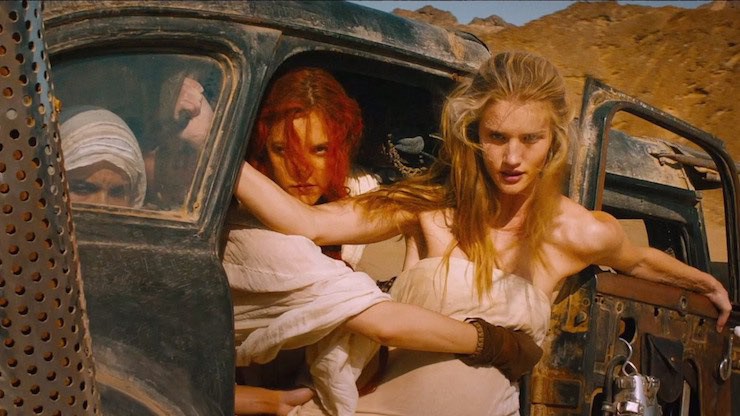
When guided by a skilled and mature director, as George Miller is, and with a narrative assembled with nuance and clarity by an editor like Margaret Sixel, the actors can tell a huge portion of the story just with their bodies, and then accentuate it with their voices. So many films rely very heavily on dialogue. In Fury Road, the dialogue expresses the height of emotion already suggested by physical acting, or imparts information that simply cannot be expressed as well through physical acting. Physical acting carries the majority of the storytelling burden for the film.
Which means that the actors must use their bodies as instruments for storytelling. The weary grudging approval of Max giving Nux a thumbs-up. Nux rising to the challenge and brow-beating his lancer for perhaps the last time to maintain his role as driver. The heartache of a world shattered as Furiosa drops to the sand to scream in frustration and sorrow. The Splendid Angharad’s proud defiance of Joe, covering Furiosa while standing half-out of the rig. All of these character moments are conveyed first and foremost through physical action.
Story in Motion
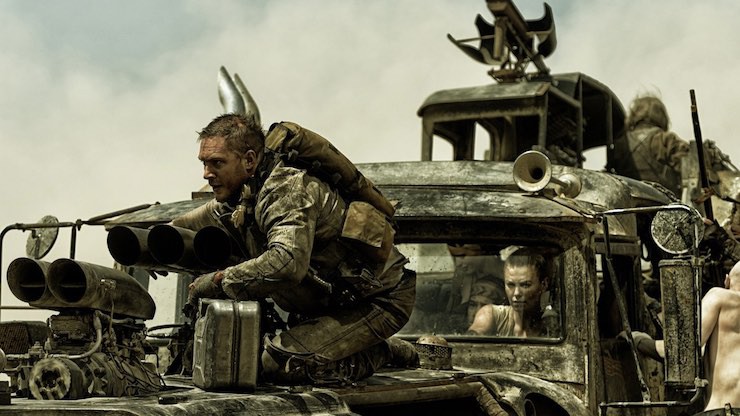
Mad Max: Fury Road is a prime example of the possibilities of action storytelling to present situations of suspense and emotional intensity that reveal character through action and reaction to events in an action/fight scene, prompt growth (a la “the hero takes a stand” moment), and more.
I’ve seen a small number of reviews that claim that Mad Max: Fury Road had negligible characterization or story. That, to me, conveys a distinct lack of understanding and/or appreciation for the nuance and sophistication of the action storytelling and characterization through movement, as executed by Theron, Hardy, and the other actors in the film. A story told in movement is still a story, and no less worthy of study and emulation.
Mad Max: Fury Road is the kind of film that can transform you, as it is a work of transformation itself—the lost finding themselves, the trapped escaping to self-definition, and learning to value life—your own and that of others. The explosions and over-saturated color and set-pieces are vehicles, they are the means to greater storytelling ends—and all of those are first and foremost about characters.
Michael R. Underwood is the author of nine books across several series. By day, he’s the North American Sales & Marketing Manager for Angry Robot Books. Mike lives in Baltimore with his wife. He is a co-host on the Hugo Award Finalist The Skiffy and Fanty Show and Speculate! The Podcast for Writers, Readers, and Fans. Mike is currently Kickstarting Genrenauts: The Complete Season One Collection.










